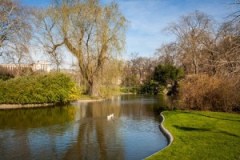Adding a wildlife habitat area to your landscape design
 Creating a wildlife habitat within your landscape design has many benefits. Besides creating a tranquil setting that supports the animals within your ecosystem, a wildlife habitat also tends to be lower maintenance by using plants that thrive in the region. The National Wildlife Federation gives a set of criteria that determines whether a design qualifies as a wildlife habitat, and each piece plays a role in attracting and sustaining wildlife.
Creating a wildlife habitat within your landscape design has many benefits. Besides creating a tranquil setting that supports the animals within your ecosystem, a wildlife habitat also tends to be lower maintenance by using plants that thrive in the region. The National Wildlife Federation gives a set of criteria that determines whether a design qualifies as a wildlife habitat, and each piece plays a role in attracting and sustaining wildlife.
What makes a wildlife habitat?
It doesn’t matter how much space you dedicate to creating wildlife habitat, as long as the area has everything the wildlife will need. The four aspects that must be involved are:
- Food sources
- Water sources
- Shelter
- An area to raise their young
So what does that entail?
The food and water sources involve native plants that have nuts, seeds, berries, fruit, or nectar. Water sources can come in the form of a stream, pond, birdbath, or some sort of water garden.
The next step is a shelter and a place to raise the animal’s young. Shelter for wildlife often utilizes dense shrub, vegetation, mature trees, a pond, or thicket. You are also encouraged to add roosting or nesting boxes, or birdhouses. Consider adding functional décor—which are artful touches that double as shelters.
What types of animals will you see?
Wildlife consists of many different species. Expect to draw birds, mammals, common amphibians, and invertebrates. You have the capability to target a specific species. For example, a pond will cater to amphibians, while trees might draw more birds.
The benefits of wildlife landscaping
Our ecosystem is essential for a thriving environment. By assisting the life cycles of native animals, we help keep our regions healthy and balanced. Watching wildlife and listening to their sounds and songs are a great way to relax and de-stress offering a retreat from our daily routine.
What type of wildlife landscaping will work for your property?
When you’re ready to design your landscape, encourage the use of elements that already exist, things like water or mature trees. Research what animals are native to your area and then ask the question: what types of wildlife would we like to support here? If you only want to dedicate a portion of the space to a wildlife habitat, then look at how you would establish its flow into the overall landscape design. If you’d like to take it one step further, the National Wildlife Federation will certify your space once it meets their standards. It is a great way to show that you are part of a network of businesses, residences, and individuals who support our nation’s wildlife.



